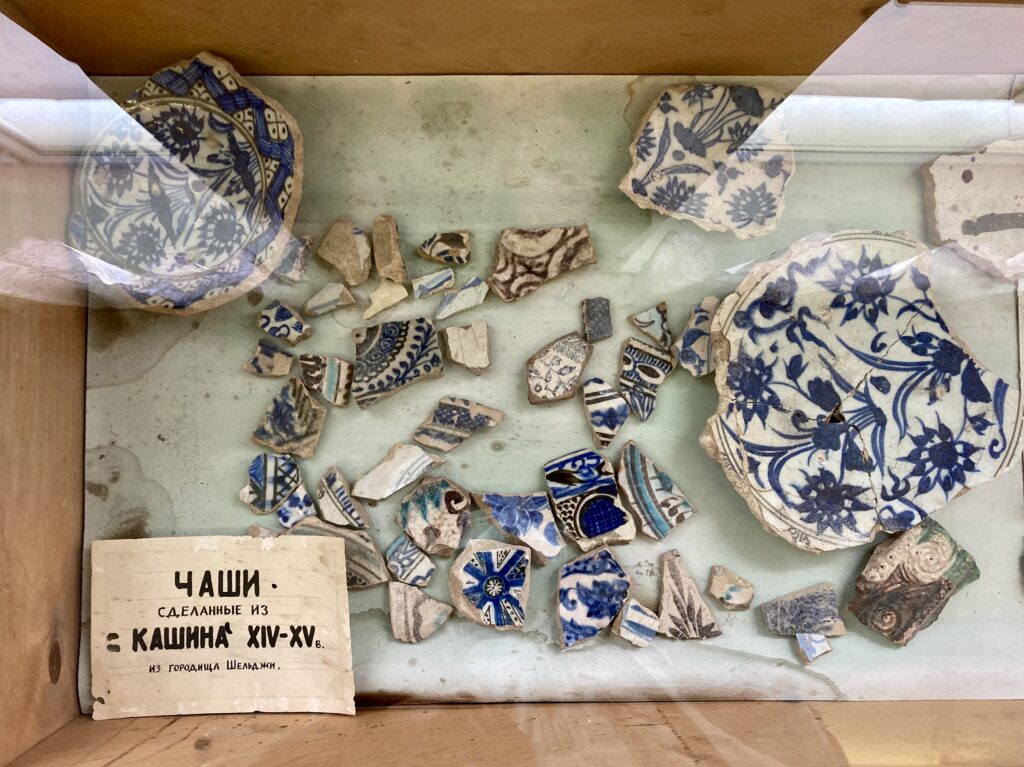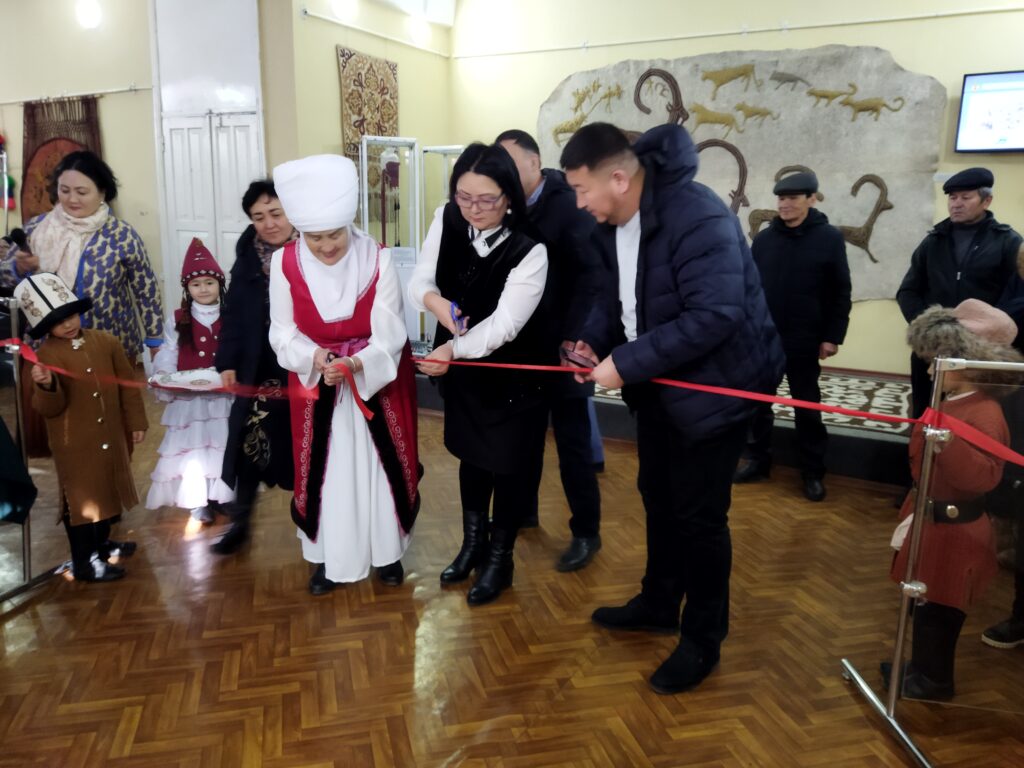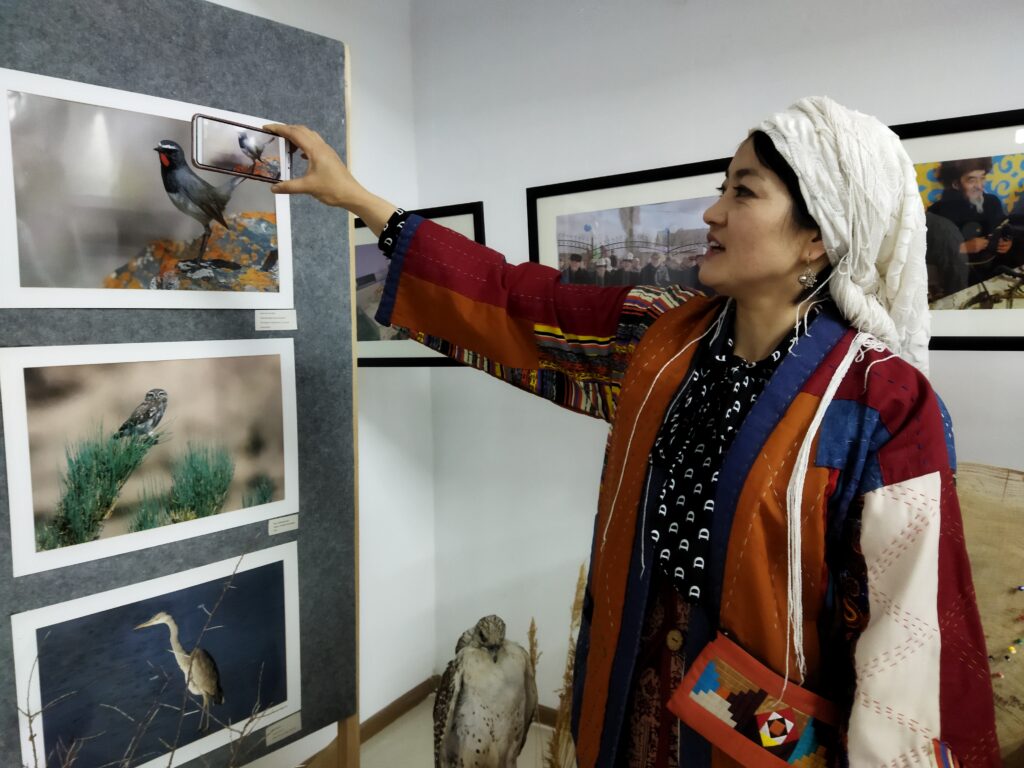Decolonising the Work Methodologies of State Museums

What is the “colonized” production of knowledge today? One can argue about definitions for a long time, but for me, the important understanding is that it is the alienation from context, from the creation of meanings, and the replacement of these with external cultural dominants. At the same time, the decolonization of knowledge production is often a very traumatic process that mostly involves the emancipatory experience of finding yourself, your context, history, background and discourse, and representing it publicly. Using our platforms, we implement processes of decolonizing knowledge and thinking.
In 2021 the School of Methodology of Art Research was launched by the Bishkek School of Contemporary Art in collaboration with the Synergy art studio.
Within the public educational program about the methodology of art research, the curatorial team (Diana Ukhina, Bermet Borubaeva) has created a platform for sharing experiences in art practices and methodologies of art research. We, as participants/facilitators of BiSCA and Synergy together with other invited actors presented and analyzed our own methodologies of art researches.
For us, a methodology forms the basis of creativity. It is a tool, not only for scientists, but also for cultural workers. The important thing for us is that the School of Methodology of Art Research is built on self-organization and solidarity, without a budget, with only personal input and resources. There is no hierarchy of knowledge, there are no teachers, only equal participants in the process of information exchange. Shifting the focus of study to ourselves or to our personal art practices became one of our active tools to decolonize knowledge in the context of artistic processes in Bishkek, an experience we reflect to the outside world too. Through the prism of the School of Methodology of Art Research, we look at our work with state museums in Kyrgyzstan.



Museums have a huge potential for the development of social relations and the formation of a space of reflectivity, search, inexplicable sensory experiences and through this the harmonization of social relations. With their potential, they can be as open as possible to everyone, without exception, regardless of separating identities such as nationality, religion, gender etc.
Most of Kyrgyzstan’s museums exist as infrastructures filled with artifacts that are interesting, valuable, and contain power, but are caught in a lifeless environment of silence and stillness. These spaces, mostly created during the Soviet period, are in no way centers of social life for local communities. They are storage facilities, some in a tolerable condition, others in a completely deplorable state – empty, dusty, falling apart physically and intellectually moribund. The only exceptions are those museums whose agenda is in one way or another close to state values, that is, patriarchal and nation-centric. Over the past two years I have been working with the Gapar Aitiev Kyrgyz National Museum of Fine Arts, focusing on women’s work. Our museum, like most museums in the world, tells an androcentric version of art history and broadcasts such views in its visual culture. Less than five percent of the main exhibition represents female artists, a fact which can always be traced back to gender-oriented decisions.
In 2020, I initiated the research project “History of 20th century art in Kyrgyzstan in the practices of female artists.” This dives into art history through the works and stories of women artists of the Soviet period in painting, graphics, sculpture, and ceramics. My colleague Alima Tokmergenova and I are carrying out research as cultural actors who create their own history, contemporaneity and memory, free of external dominant stories, canons and structures. We do a study of the museum’s institutional memory of female artists, whose works were in collection from its inception (1935) until the early 1990s, but for the most part were not available to the audience.
The museum’s management was open to us working on the following as external, independent researchers:
- 1) Carrying out work with the museum library (sorting books, exhibition catalogs, identifying information about artists, e.g. their names and stories, and getting to know the museum library classification system and archive)
- 2) Creating an online research exhibition of female artists from library materials
- 3) Working with the museum collection to curate an exhibition from its closed funds. (We exhibited around 140 works by 22 female artists).
- 4) Cooperating with the museum to publish a catalog about female artists based on the work done.
The openness of the museum’s leadership allowed us to generate a long-term research base about female artists and start bringing impulses into it from our work as external actors.
However, the museum largely functions within the collapsing system of Soviet inertia. A good collection is basically from the last century and includes painting, sculpture, graphics, folk arts and crafts. The museum’s understanding of itself is, first and foremost, as a state institution, not a social one. There are many current problems: no permanent public program, almost no scientific work, few staff members with relevant education and a minimal budget covering only small salaries and utility costs.
It feels like museum work happens on isolated islands on which life takes place, but where, on the whole, stagnation and loss are felt. This is a living creature in some aspects, but even more a sleeping creature. A creature on the basis of which it is possible to enable the cultural transformation of the whole country, if this force is awakened and connected with the dormant potentials of the museum network throughout the country1.
Bishkek has several memorial museums dedicated to the life and work of artists and cultural figures. One of them is the house of the sculptor Olga Manuilova. When we come to the administration of the museum, we see that the people in charge are always open to our suggestions and ideas, they are ready to collaborate. But when it comes to implementing our ideas, we understand that their work is primarily aimed at conserving the place, the history of the house. In 2015, we had an experience (based on our interest and conversations with museum’s leadership) to work with the collection of the Olga Manuilova Museum to create a two-week research exhibition titled “Art and emancipation: Olga Manuilova and her contemporaries”. Visitors got the opportunity to interact with the house-museum and its different parts in a different way. The budget for the research exhibition was under 100 US dollars from our own resources.
Such days and work processes are very inspiring, we want to implement even more ideas in the museum to make it a more lively space, so that visitors can come not only to see the exposition, but to interact with it in various formats. And the artistic processes that can take place here should concern not only the past, but also the present, the moment in which we live, what we face today in culture and art as cultural actors and as spectators.
Based on this and other experiences, we came to the Issyk-Kul region to initiate the Participatory Museum project for museum workers. There were three of us: art historian Oksana Kapishnikova, curator and researcher Diana Ukhina and researcher Alima Tokmergenova.
And it felt strange: what can we teach people who have been working in museums almost all their lives? But perhaps this is where the problem is hiding. The museums of the Issyk-Kul region are located in a historical area that is developed for tourism, but the display and work experience are fundamentally built on what was created in the Soviet time.
The country does not train new museum specialists (the Faculty of Art History reopened in 2022 after a long break) but hires them from sometimes vaguely related fields, and everything rests on the older generation. Given the current state of public finances, which means culture and museums receive only residual funding, there are new challenges in working with the museum audience and these require new approaches. For three days on the shore of Issyk-Kul, we shared our experiences, and the museum staff talked about their work, museums, and the issues that concern them today. We talked about how to implement visitor surveys and art research, and how to create exhibitions on a small budget. The seminar was attended by employees of the local history museums of Cholpon-Ata and Balykchy, as well as the Center for Nomadic Civilization.
The Participatory Museum is an educational program for employees of museums in the Issyk-Kul region, consisting of two parts: theoretical part (a three-day seminar) and practical part (research, creation of an exhibition and publication). The goal is to get acquainted with new museum practices.
Over the following months, the participants of this project conducted visitor surveys and artistic research, and we kept in touch with them, consulting and helping. The project received a small honorarium and a budget for research and presentations. Two exhibitions finally opened in January 2022.
The Issyk-Kul State Historical and Cultural Museum-Reserve of Cholpon-Ata presented the results of a research of the history of the city, or rather Sovetskaya Street, which is the main street of the city. They displayed stories around it based on archival data and oral histories of residents and eyewitnesses of different times. The Center of nomadic civilization in the village Chon Sary Oi worked with communities. At the exhibition they presented a large display about the flora and fauna of the village, using interactive elements and multimedia.
As a result of the project, we created a zine-guide for the Participatory Museum, which included the working materials of the educational program, intermediate stages of research, as well as photographs of the exhibitions. We believe that this zine can be used by other museum workers in different cities around the country.





This kind of communication with museums allows us to be together in the field of mutual learning. We learn from them, they take something from our experience; we believe that they implement this in their practices. I would like to expand this educational circle, opening up spaces for audiences, visitors who can become accomplices, co-authors of the development process of a museum or cultural institution. These can become important cultural centers, public places on various levels for the dissemination of knowledge and exchange of experience, and as spaces for experimentation and freedom.
My field of interest is primarily small museums in Kyrgyzstan, which were formed not as the result of a directive from above (the government), but from grassroots initiatives – self-organized cultural institutions, so-called public museums. Here, the word “public” is not about publicity, but the involvement of the community in the formation and functioning of the museum. What were the reasons for their foundation, for whom did they act, what was their role, and how did they work now?
In the 1960s and 1970s, there was a museum boom in the Soviet Union, including in Kyrgyzstan. Everywhere in cities, villages, and schools, “public museums” were opened, forming a museum network. For the most part, these were museums accompanying historical memorials and local history museums created for the purpose of archiving history and artifacts, educational activities, and representing mainly the interests of local communities.
These small museums constantly conducted active educational work in the local community, with villagers and students who were direct participants in their formation and functioning. Today, the situation has changed radically. On the one hand, this is due to museum inertia, to the low qualifications and low salaries of museum employees. On the other, there is no interest in the community, not only in development, but even in supporting and visiting these museums, and this is dictated by the fact that they do not change and nothing happens in them.
I want to know why museums are lifeless and little visited today. I understand how strong the personal factor can play, in which there is a desire to do something, create, and change.
Small museums based on the principle of self-organization of a community or an individual are actively functioning, being filled and developed by its creators. Often, with the departure of the museum’s initiator, the process of stagnation or even regression begins in the institution.
Often at our local museum conferences, you can hear discussions on the topic of museum inertia and how to overcome it. Alienation of labor is inherent in many state structures. Often this is due to the underestimation of knowledgeable workers, who have low salaries (30 to 45 euros per month), which forces them to take on additional jobs. They direct all their energy into survival and not into creating or producing. Hence the alienation and inertia of labor. This situation leads to a certain vicious circle, which contributes to the closure of small museums.
The museum structure is primarily created, maintained, and developed in the interests of the museum staff and the local community around which it is formed. Today, in the capitalist paradigm, the private begins to prevail over the public – “WE” rhetoric has changed to “SOMEONE”, where “WE” are no longer interested. Yet, on the contrary, the development of the museum requires the predominance of public consciousness and creation. In collective co-creation, constant dialogue (viewer-museum), procedural understanding of the common cause can be formed into something new.
Thus, the methodological approaches of the BiSCA’s work with institutional structures and the decolonization of knowledge can be systematized as follows:
- 1) Study of the conditions of the museums (content, infrastructure, relevance, openness, inertia) – museums in the regions (Museum of Participation project in Issyk-Kul and the Herzen Museum in the Talas region) and in the capital (KNMofFA named after G. Aitiev).
- 2) Work with the museum collection, museum literature, implementation and promotion of curatorial and research approaches (KNMofFA named after G. Aitiev and the Herzen Museum in the Talas region).
- 3) Conducting educational programs for museum employees about artistic methods of research, working with the audience and transformation of museum from repository to social form (Museum of Participation)
All this can be described as “education in practice” through the flow around solid structures. This is our conscious and unconscious agenda; these are our ways to decolonize the artistic sphere, art education, and ourselves from the rigid and patriarchal governmental structures. Only in this way, in our context, can an independent museum agenda be implemented, aimed at unlocking the potential of the museums and forming a harmonious social structure, both between people and between humanity and the planet. If we look through the optics of the sociology of culture, culture determines social relations and superstructures. Thus, through the potential of museums as possibly inclusive public structures, we can work with consciousness, free the collective imagination from dogmas regarding social order, and remove social prohibitions on the mutual right to be ourselves and accept the boundaries of others.